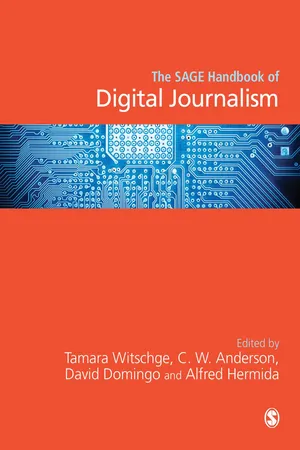
The SAGE Handbook of Digital Journalism
- 624 pages
- English
- ePUB (mobile friendly)
- Available on iOS & Android
The SAGE Handbook of Digital Journalism
About This Book
The production and consumption of news in the digital era is blurring the boundaries between professionals, citizens and activists. Actors producing information are multiplying, but still media companies hold central position. Journalism research faces important challenges to capture, examine, and understand the current news environment. The SAGE Handbook of Digital Journalism starts from the pressing need for a thorough and bold debate to redefine the assumptions of research in the changing field of journalism. The 38 chapters, written by a team of global experts, are organised into four key areas:
Section A: Changing Contexts
Section B: News Practices in the Digital Era
Section C: Conceptualizations of Journalism
Section D: Research Strategies
By addressing both institutional and non-institutional news production and providing ample attention to the question 'who is a journalist?' and the changing practices of news audiences in the digital era, this Handbook shapes the field and defines the roadmap for the research challenges that scholars will face in the coming decades.
Frequently asked questions
Information
Table of contents
- Cover
- Half Title
- Title Page
- Copyright Page
- Contents
- Illustration List
- Notes on the Editors and Contributors
- Introduction
- Part I Changing Contexts
- 1 Digital Journalism and Democracy
- 2 Global Media Power
- 3 Digital News Media and Ethnic Minorities
- 4 The Business of News
- 5 Digital Journalism Ethics
- 6 Social Media and the News
- 7 Networked Framing and Gatekeeping
- 8 The Intimization of Journalism
- 9 Emotion and Journalism
- Part II News Practices in the Digital Era
- 10 Networked Journalism
- 11 Hybrid News Practices
- 12 The Ecology of Participation
- 13 Innovation in the Newsroom
- 14 Outsourcing Newswork
- 15 Semi-professional Amateurs
- 16 Sources as News Producers
- 17 Activists as News Producers
- 18 Citizen Witnesses
- 19 Hyperlocal News
- Part III Conceptualizations of Journalism
- 20 Normative Models of Digital Journalism
- 21 Mass, Audience, and the Public
- 22 Digital Journalism as Practice
- 23 Mapping the Human–Machine Divide in Journalism
- 24 Spaces and Places of News Consumption
- 25 News Institutions
- 26 Journalistic Fields
- 27 News Networks
- 28 News Ecosystems
- 29 Liquid Journalism
- Part IV Research Strategies
- 30 Ethnography of Digital News Production
- 31 Adopting a ‘Material Sensibility’ in Journalism Studies
- 32 Reconstructing Production Practices through Interviewing
- 33 Sampling Liquid Journalism
- 34 Big Data Analysis
- 35 Q-method and News Audience Research
- 36 Practicing Audience-centred Journalism Research
- 37 Multi-method Approaches
- Author Index
- Index